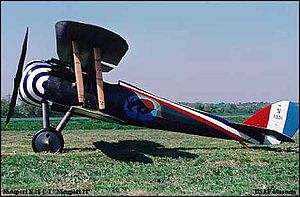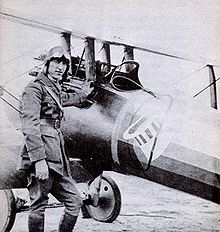- Nieuport 28
-
Nieuport 28 Reproduction of the Nieuport 28 at the National Museum of the United States Air Force Role Fighter Manufacturer Nieuport Designer Gustave Delage First flight 14 June 1917 Introduction March 1918 Retired July 1918 Primary users U.S. Army Air Service
Aéronautique MilitaireNumber built about 300 The Nieuport 28 (N.28C-1) was a French biplane fighter aircraft flown during World War I, built by Nieuport and designed by Gustave Delage. Its principal claim to fame is that it was the first aircraft to see service with an American fighter squadron.
Contents
Design and development
By the middle of 1917 it was obvious that the Nieuport 17 was unable to cope with the latest German fighters, and that direct developments of the 17, such as the Nieuport 24bis. were unable to offer a substantially improved performance. In fact, the Nieuport was already being rapidly replaced in French service with the SPAD S.VII.[1]
The Nieuport 28 design was an attempt to adapt the concept of the lightly built, highly maneuverable rotary engined fighter typified by the Nieuport 17 to the more demanding conditions of the times. It had a more powerful engine, and a new wing structure – for the first time a Nieuport biplane was fitted with conventional two spar wings, top and bottom, in place of the sesquiplane "v-strut" layout of earlier Nieuport types. Ailerons were fitted to the lower wings only. The tail unit’s design closely followed that of the Nieuport 27, but the fuselage was much slimmer, in fact it was so narrow that the machine guns had to be offset to the left.[2] The prototype (and, perhaps a handful of early production aircraft) had marked dihedral in the top wing only and a tightly spaced cabane structure. Production machines had only a slight dihedral in the upper wing, taller cabane struts, and two Vickers machine guns.
Operational history
By early 1918, when the first production Nieuport 28s became available, the type was already “surplus” from the French point of view. The SPAD S.XIII was a superior aircraft in most respects, and was in any case firmly established as the standard French fighter.[3]
On the other hand, the United States Army Air Service was desperately short of fighters to equip its projected “pursuit” (fighter) squadrons. The SPAD was initially unavailable due to a shortage of Hispano-Suiza engines – and the Nieuport was offered to, and perforce accepted by, the American Expeditionary Force (AEF), as an interim alternative. A total of 297 Nieuport 28s were purchased by the Americans, and they were used to equip the very first American fighter squadrons, starting in March 1918. All together, four AEF "pursuit" squadrons flew 28s operationally, the 27th, 94th, 95th and 103rd Aero Squadrons.[4]
Due to an early shortage of machine guns in the American squadrons some early patrols were flown with one machine gun. On 14 April 1918, the second armed patrol of an AEF fighter unit resulted in two victories when Lieutenants Alan Winslow and Douglas Campbell (the first American-trained ace) of the 94th Aero Squadron each downed an enemy aircraft. Several well known World War I American fighter pilots, including Quentin Roosevelt, the son of US president Theodore Roosevelt, as well as American aces like the 26-victory ace, Captain Eddie Rickenbacker, began their operational careers on the Nieuport 28.[5]
On the whole the type was not a success, however. Although very maneuverable and easy to fly, its performance turned out to be mediocre and its engine unreliable. More seriously, the mixed plywood/fabric skinning of the wings proved problematic – the fabric which covered the rear portion of the wings tending to “balloon” and become detached from the plywood leading section. Although a solution to this problem was speedily found, the operational Nieuports in American service were replaced with SPADs as soon as sufficient of the latter became available. This process was complete by the end of July 1918.[6]
After the end of the war some examples of the type crossed the Atlantic with the returning American forces with a small number supplied to various foreign air forces. Switzerland obtained 15 Nieuport 28s and Greece received a small number of aircraft.[7]
Operators
 Argentina
Argentina- (2 aircraft)
 France
France Greece
Greece Guatemala
Guatemala- (1 aircraft)
 Switzerland
Switzerland- (15 aircraft)
 United States
United States
Specifications (Nieuport 28)
General characteristics
- Crew: one, pilot
- Length: 6.50 m (21 ft 4 in)
- Wingspan: 8.16 m (26 ft 9 in)
- Height: 2.5 m (8 ft 0 in)
- Wing area: 15.8 m² (169 ft²)
- Empty weight: 475 kg (1,227 lb)
- Loaded weight: 560 kg (1,635 lb)
- Powerplant: 1 × Gnome 9-N rotary, 102kW (160 hp)
Performance
- Maximum speed: 184 km/h (122 mph)
- Range: 349 km (180 miles)
- Service ceiling: 5300 m (17,390 ft)
- Rate of climb: 11.5 min to 3,000 m (9,840 ft)
- Wing loading: 37.9 kg/m² (7.77 lb/ft²)
- Power/mass: 0.15 kW/kg (0.09 hp/lb)
Armament
See also
- Related lists
List of military aircraft of France
References
Notes
- ^ Cheesman 1960, p. 94.
- ^ "Nieuport 28C-1." nasm.si.edu. Retrieved: 30 August 2009.
- ^ Cheesman 1960, p. 106.
- ^ Dorr and Donald 1990, pp. 16–17.
- ^ Treadwell 2000
- ^ Cheesman 1960, p. 98.
- ^ van Leeuwen, Marcel. Nieuport 28 zap16.com, 30 December 2008. Retrieved: 30 August 2009.
Bibliography
- Cheesman E.F. (ed.) Fighter Aircraft of the 1914-1918 War. Letchworth, UK: Harleyford Publications, 1960, pp. 98–99.
- Cooksley, Peter. Nieuport Fighters in Action (Aircraft No. 167). Carrollton, Texas: Squadron/Signal Publications, 1997. ISBN 0-89747-377-9.
- Dorr, Robert F. and David Donald. Fighters of the United States Air Force. London: Aerospace Publishing, 1990. ISBN 0-60055-094-X.
- Treadwell, Terry C. America's First Air War. London: Airlife Publishing, 2000. ISBN 1-84037-113-7.
External links
Aircraft produced by Nieuport Nieuport Nieuport-Delage Nieuport-Delage NiD 29 • 30T • 32 • 33 • 38 • 40 • 41/42S • 42C • 43 • 48 • 52 • 62 • 121/125 • 390/391 • 450/650 • 580 • 590 • 640/631/642 • 941 • Nieuport-Delage SesquiplanLoire-Nieuport People and aircraft Campaigns and battles Strategic bombing (German, Cuxhaven) · Bombing of cities · Fokker Scourge · Flight over Vienna · Bloody April · BattlesEntente Powers air services Australian Flying Corps · British air services (Royal Flying Corps, Royal Naval Air Service, Royal Air Force) · French Air Service · Imperial Russian Air Force · Italian Military Air Corps · United States Army Air Service · Greek air services (Army Air Service, Naval Air Service)Central Powers air services German air services (Army Air Service, Navy Air Service) · Austro-Hungarian Imperial and Royal Aviation Troops · Ottoman Air Force · Bulgarian Army Aeroplane SectionLists relating to aviation General Aircraft (manufacturers) · Aircraft engines (manufacturers) · Airlines (defunct) · Airports · Civil authorities · Museums · Registration prefixes · Rotorcraft (manufacturers) · TimelineMilitary Accidents/incidents Records Categories:- French fighter aircraft 1910–1919
- Military aircraft of World War I
- Nieuport aircraft
Wikimedia Foundation. 2010.


